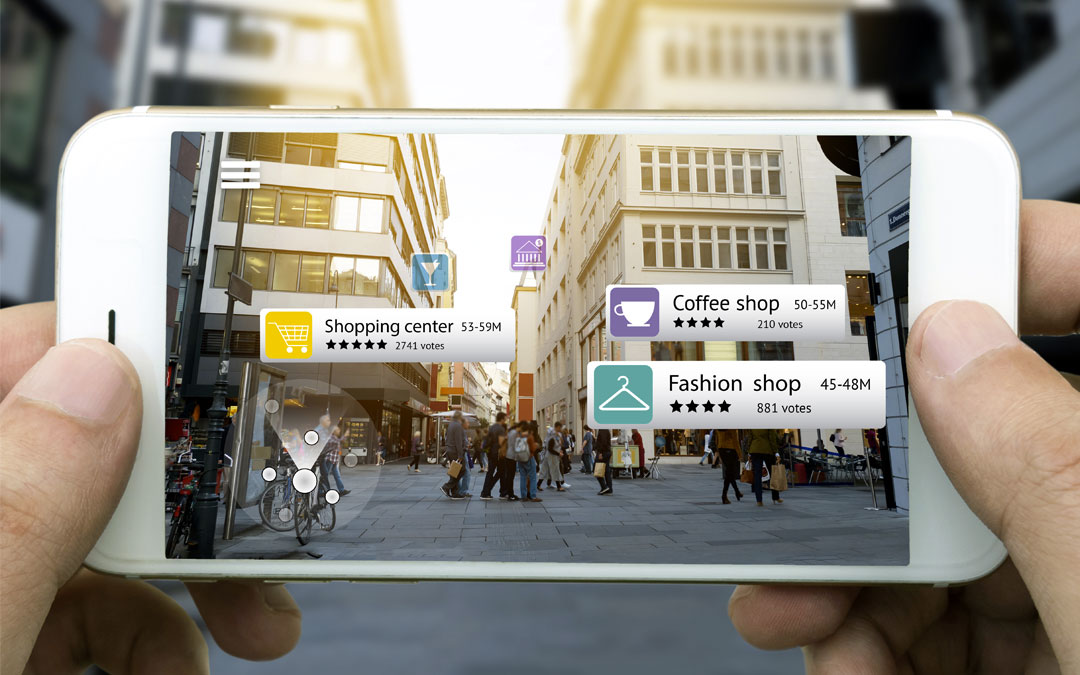After skirting arena of development for many decades augmented reality finally has arrived- in full swing. Be it communication, interactive working and problem solving, augmented reality has evolved into a phenomenon. It is not just restricted to stereotypical 2D and 3D overlays but also context-oriented and personalized experiences.
The new improved AR empowers contextual computing with attributes like machine-learning, sensors, big data, social media, artificial intelligence and so on to deliver significant information and experiences that are personalized, scalable and intuitive.
The new improved AR empowers contextual computing with attributes like machine-learning, sensors, big data, social media, artificial intelligence and so on to deliver significant information and experiences that are personalized, scalable and intuitive.
So, UX designers are in all gains with tremendous opportunities to explore this emerging medium to modify reality. With much trendy Google Glass, FieldTrip app and Oculus Rift urging many brands to experiment with features, consumers are bound to be flabbergasted by the products.
The truth is, augmented reality has changed the dimension of user experience by fading the lines between the digital and physical environment. In this post, we shall understand how AR is refining the user experience. But first things first, what does augmented reality mean?
The Meaning
Augmented reality refers to computer-generated information applied with the help of sensor-packed wearable device over products and systems in the real world. It includes the user’s perspective of the real world and coats a digital film to it that has data and information so as to sharpen our outlook and experience with the real world.
Augmented technology first arrived in the field of entertainment and technology in the late 1990s. It was in 1998 that 1st and Ten Computer System was shown by Sportsvision, producing the first virtual yellow down marker at a live NFL game. These days, digital designers are employing augmented reality to deliver mind-blowing user experience.
The Merits
A. Real-time User Feedback
AR technology integrates the digital with the physical to give the user real-time feedback on what they’re doing. With AR apps, instead of looking at information, users access it and get real-time live feedback on the action they have performed. With the latest mélange of augmented reality and the Internet of Things, AR dashboards are more and more used for real-time simulation.
According to a recent study on advantages of real-time feedback in mobile augmented reality with portable devices, it was observed that AR can contribute in decreasing the need to transfer focus between guidelines and physical objects. The apps governed on AR give real-time feedback to users on their actions, which tell whether they are on track or not plus it gives them an in-depth knowledge of their searches.
B. Redefining Brand UX
It is important to distinguish augmented reality and its close cousin virtual reality from the brand point of view. Remember, when it comes to brands, customer loyalty keeps the revenue going. According to a research, involved customers purchase 90% more frequently, invest 60% more per transaction and are five times more prone to be loyal to a brand. To make the customers stick to a brand, one needs to be careful with the user experience. So, designers need to strain every nerve in order to enhance user experience with the aid of augmented reality.
To make the customers stick to a brand, one needs to be careful with the user experience. So, designers need to strain every nerve in order to enhance user experience with the aid of augmented reality.
Functioning on a tablet or Smartphone with just a click, AR apps contribute big time to the user journey. They guide the user in making buying decisions, augment the fun factor and lead them to extract more out of their products. They deliver more sort of a personal experience.
For example, Pokémon Go, a location governed augmented reality game app for iOS and Android has transported games from the couch into the real-world, motivating users to make the most of their gaming experience. End Result- within a week of the game hitting the market, 65 million people were hooked to Pokémon Go already.
Why? It was like a dream come true. The AR attributes of the game's UI were perfect, much like bringing life to the gaming experience. The in-game creatures were to be located in real-life settings. That's what memorable experience demands!
Understanding Design Better
AR can hasten work processes and has even established itself as a valuable learning tool in business. As per a survey, the use of augmented reality apps in the market will rise to $2.4 billion by the year 2019; that is almost tenfold of its current rate. For example, popular car brands such as Volkswagen and Audi are keying on AR and an understandable model-based definition to curate service manuals that assists the user in managing or undertaking maintenance on their vehicle. That means even a novice motorist can go ahead with the repairs on their vehicle.
Days are not far when AR will be a part of hyper-training in organizations to groom onboard new employees. AR can instruct the employees on proper protocol to be followed in certain situations and arm them for real-world scenarios well in time.
By molding new hires for real-world scenarios where they are required to fulfill their duties, which otherwise wouldn't have been possible outside of the actual work in past, we can multiply productivity, save time and resources and also keep work-related injuries and accidents at bay.
The Process
Segment and Plan
Not all apps are alike. The environmental conditions always bring out a different story and even determine the interactions the users have. First, keep ‘public’ in mind as a whole, then comes ‘intimate’ where you have to imagine the user in front of their desktop computer with a webcam.
Further, in ‘personal’ take into consideration a Smartphone in a public 360 degrees space. Lastly, the newest category, ‘private’ has wearable tech like glasses in Google Glass or headgear in Oculus Rift. This enables both personal and intimate experience that is sensory as well as visual. Recognising such scenarios helps a lot in understanding interaction design and technical needs, that too, before the start of the process.
Get Real
An AR app is pretty complicated in itself as unlike a website which works on the standard set of conditions, the environmental conditions of an AR app are very vast as well as challenging. Details are very important here. While calculating the technical requirements, always keep the user in mind. If the campaign hovers in real-world locations in public spaces, be very particular when it comes to reception quality and safety. These small intricacies will save you from trouble later.
Screen Comes First
Designers may be habitual to work on their advanced iMac, but don't forget that most users will operate on something smaller, so concentrate on their experience. Working on small screen here means that the typefaces must be clear and visible to read, colors must be in good contrast and selected in a way that they don’t disrupt the user’s view. This becomes all the more crucial when designing for wearable displays where there is less physical space to be managed. Eye strain or fatigue is another issue that can come up with heavy duty animations.
Mental Challenge
Fatigue is not all about eyes here. No matter how much people might have cherished the experience, still they can’t cope up with holding a device for an extended period of time. Don’t even expect that they will be walking around staring at a small mobile screen for a long duration of time. That is not only distracting but also dangerous.
A higher degree of interaction while sitting or if the mobile is at a chest level based on a near-full extension of their arm and elbow is still tolerable.
Consider Frame Rates
AR experiences have a potential to go as high as 60 fps. But the problem is that for this level of animation, the processing power has to be super too. Consider the complexity of the 3D objects and the frame rate with which they are compatible. Get to that sweet spot using the variety of user devices.
Make sure that you optimise the application before it hits the market to guarantee pleasant experience, no matter what the device is. Keep in view the overall ‘feel’ of the experience as well. Try to smoothly integrate experiences into the real world. In short, think in 3D space.
For Both Hands
While working on an AR experience in public space, score on the grounds of automation in the app. Users find it very difficult to maneuver a device with one hand. Fix your eyes on the screen and then include tap or swipe navigation elements with the other hand. Using both the hands will provide a better experience to the user and they will concentrate more on the experience rather than the device.
The Challenges
Spam Threats
To fulfill their advanced functions, web and mobile apps often rely on a variety of data. Old web mobile apps such as Dropbox and Facebook ask for gaining access to user data and hardware for the purpose of account management. Keep in mind that the security risks related to complicated AR apps are higher as the data should be rich and generally on sensing.
Dangerous apps are always on the lookout of launching location-based attacks, get hold of the Wi-Fi password and even damage security apps. But there are some companies who reserve the rights to forward the data their apps list with third parties such as Pokémon Go.
Internet Dependency
Augmented reality is about engrossing the user at any given moment in the experience. These experiences are the end result of smooth interactions that smudge the lines between real and digital. But if the user while in the process of getting absorbed gets drifted away from the real world, it could lead to unhealthy dependency on the imaginary. Till now, no augmented reality app has been able to achieve complete immersion because of hardware restrictions.
Reinventing UX Principles
With user experience on a surge, digital designers learned that the user is of supreme importance and their work needs to be relished by them. With this innovation in design thinking, new terminology must be grasped, new tools must be brought forward, new data was collected and new workflows were introduced. Now with the fast pace of the AR movement, designers need to acquaint themselves with a new set of jargons like modulated reality and dead reckoning and advanced design aids like Vuforia and Unity 3D.
What are Virtual and Augmented Realities?
End Note
Technology should make our lives dynamic and not halt its flow. With its work in the background, what matters is timely emergence to increase productivity and connectivity of the things that are significant. Still, best practices haven’t surfaced for augmented, virtual or mixed reality, so they aren’t any standardized concepts. UX designers need to put in time and effort so as to gauge users’ current and future expectations based on new technology and then execute design efforts. The question that matters the most as of now is how we can pave AR experiences so that a user’s life becomes easier. So, fellas, is your AR treasure hunt on?



